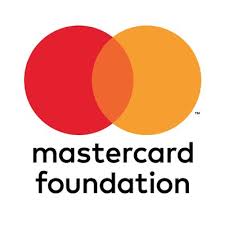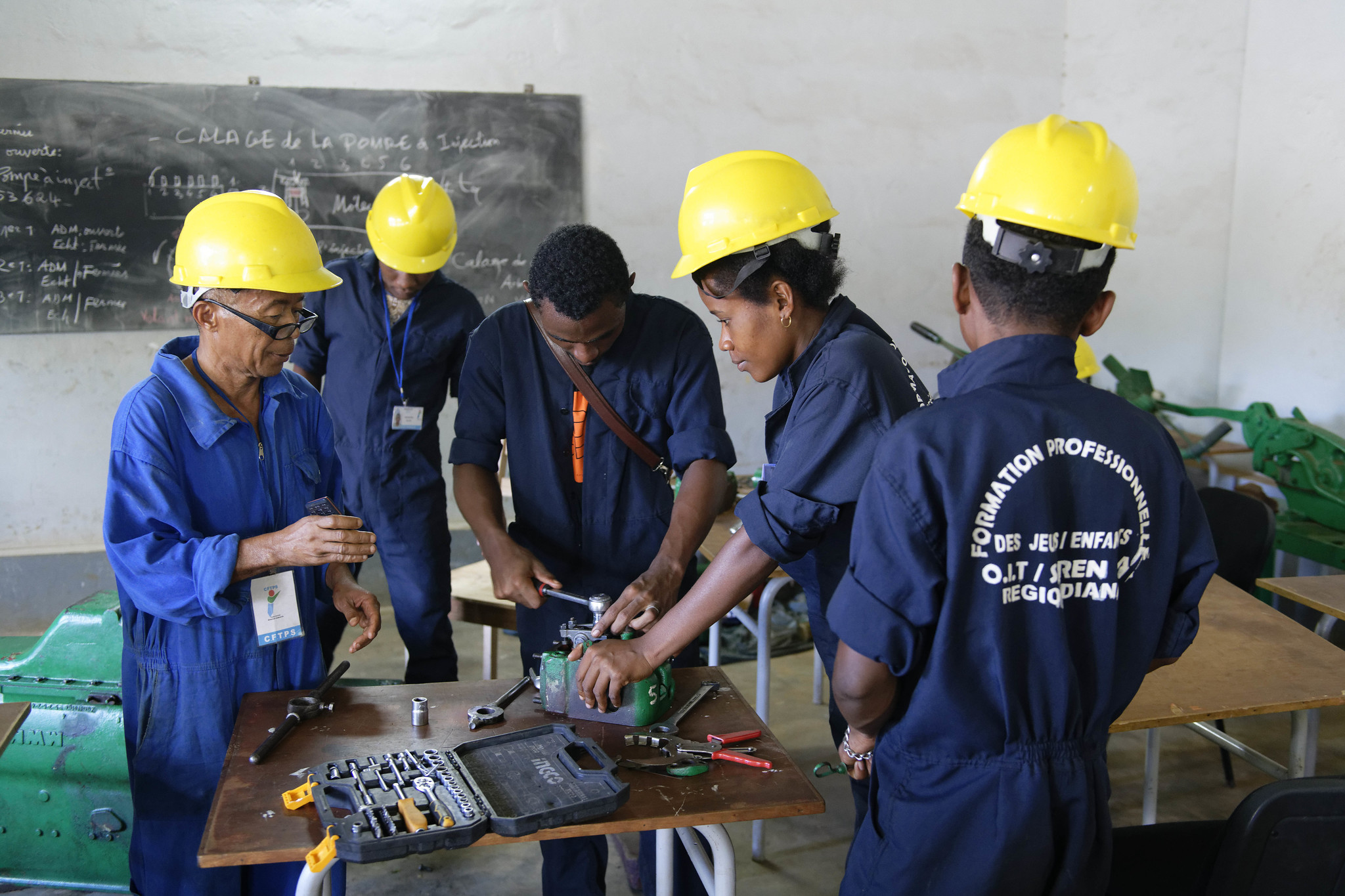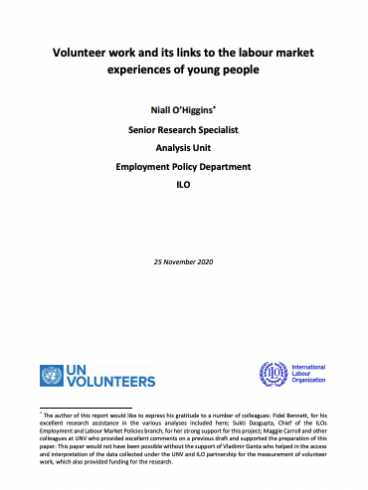Índice de contenidos
Páginas relacionadas
Introducción
En muchos países, la situación laboral de los jóvenes es preocupante. La informalidad y la vulnerabilidad la ocupación siguen siendo una desafortunada realidad para la mayoría de los jóvenes empleados de todo el mundo. Además, cuando no están en la ocupación, los jóvenes tienen dificultades para acceder al mercado laboral. Esto se refleja en las elevadas tasas de la desocupación jóvenes, las altas tasas de ninis (que no cursan la ocupación, educación ni formación) y la a menudo difícil transición de la escuela al trabajo.
En la Agenda 2030 para el Desarrollo Sostenible, la comunidad internacional se comprometió a aumentar las oportunidades de los jóvenes la ocupación y a reducir sustancialmente la proporción de jóvenes que no cursan estudios, la ocupación ni reciben formación(ODS 8.6). En este contexto, las estadísticas laborales detalladas sobre los jóvenes proporcionan información vital para apoyar a los gobiernos y a la sociedad civil en sus esfuerzos por diseñar, aplicar y supervisar políticas que promuevan mejores resultados para los jóvenes la ocupación .
Catálogo de datos
A continuación se presenta un subconjunto de los indicadores disponibles sobre los jóvenes, que se definen como personas de entre 15 y 29 años en la base de datos de las Estadísticas del Mercado Laboral de los Jóvenes (YouthSTATS) únicamente. Para ver todos los indicadores disponibles por edad, que incluyen una categoría para personas de 15 a 24 años, consulte la página de datos.
| Indicador | Frecuencia | Base de datos | Asunto | Descargar (con etiquetas) | Descargar (con códigos) | Explorador de datos |
|---|---|---|---|---|---|---|
| Población joven en edad de trabajar con formación profesional según sexo y edad (miles) | Anual | Indicadores del Mercado Laboral Juvenil (YouthSTATS) | Aprendizaje en el trabajo | .csv .dta .xlsx | .csv.gz | |
| Jóvenes que aprenden en el trabajo según sexo y tipo (miles) | Anual | Indicadores del Mercado Laboral Juvenil (YouthSTATS) | Aprendizaje en el trabajo | .csv .dta .xlsx | .csv.gz | |
| Población juvenil en edad de trabajar según sexo, edad y educación (miles) | Anual | Indicadores del Mercado Laboral Juvenil (YouthSTATS) | Población | .csv .dta .xlsx | .csv.gz | |
| Población juvenil en edad de trabajar según sexo, edad y zonas rurales / urbanas (miles) | Anual | Indicadores del Mercado Laboral Juvenil (YouthSTATS) | Población | .csv .dta .xlsx | .csv.gz | |
| Población juvenil en edad de trabajar según sexo, edad, y estado de la asistencia escolar (miles) | Anual | Indicadores del Mercado Laboral Juvenil (YouthSTATS) | Población | .csv .dta .xlsx | .csv.gz | |
| Población juvenil en edad de trabajar según sexo, edad y situación en términos de discapacidad (miles) | Anual | Indicadores del Mercado Laboral Juvenil (YouthSTATS) | Población | .csv .dta .xlsx | .csv.gz | |
| Población juvenil en edad de trabajar según sexo, edad y situación en el mercado de (miles) | Anual | Indicadores del Mercado Laboral Juvenil (YouthSTATS) | Población | .csv .dta .xlsx | .csv.gz | |
| Población juvenil en edad de trabajar según sexo, edad y etapas de transición (miles) | Anual | Indicadores del Mercado Laboral Juvenil (YouthSTATS) | Población | .csv .dta .xlsx | .csv.gz | |
| Población juvenil en edad de trabajar según sexo, zonas rurales / urbanas y etapas de transición (miles) | Anual | Indicadores del Mercado Laboral Juvenil (YouthSTATS) | Población | .csv .dta .xlsx | .csv.gz | |
| Población juvenil en edad de trabajar según sexo, educación y etapas de transición (miles) | Anual | Indicadores del Mercado Laboral Juvenil (YouthSTATS) | Población | .csv .dta .xlsx | .csv.gz | |
| Población juvenil en edad de trabajar según sexo, edad y formas de transición (miles) | Anual | Indicadores del Mercado Laboral Juvenil (YouthSTATS) | Población | .csv .dta .xlsx | .csv.gz | |
| Población juvenil en edad de trabajar según sexo, zonas rurales / urbanas y formas de transición (miles) | Anual | Indicadores del Mercado Laboral Juvenil (YouthSTATS) | Población | .csv .dta .xlsx | .csv.gz | |
| Población juvenil en edad de trabajar según sexo, educación y formas de transición (miles) | Anual | Indicadores del Mercado Laboral Juvenil (YouthSTATS) | Población | .csv .dta .xlsx | .csv.gz | |
| Jóvenes transitados según sexo y situación en la ocupación (miles) | Anual | Indicadores del Mercado Laboral Juvenil (YouthSTATS) | Transición de la escuela al trabajo | .csv .dta .xlsx | .csv.gz | |
| Jóvenes transitados según sexo y actividad económica (miles) | Anual | Indicadores del Mercado Laboral Juvenil (YouthSTATS) | Transición de la escuela al trabajo | .csv .dta .xlsx | .csv.gz | |
| Jóvenes transitados según sexo y ocupación (miles) | Anual | Indicadores del Mercado Laboral Juvenil (YouthSTATS) | Transición de la escuela al trabajo | .csv .dta .xlsx | .csv.gz | |
| Fuerza de trabajo juvenil según sexo, edad y educación (miles) | Anual | Indicadores del Mercado Laboral Juvenil (YouthSTATS) | Fuerza de trabajo | .csv .dta .xlsx | .csv.gz | |
| Fuerza de trabajo juvenil por sexo, edad y zonas rurales / urbanas (millas) | Anual | Indicadores del Mercado Laboral Juvenil (YouthSTATS) | Fuerza de trabajo | .csv .dta .xlsx | .csv.gz | |
| Fuerza de trabajo juvenil según sexo, edad y estado de la asistencia escolar (miles) | Anual | Indicadores del Mercado Laboral Juvenil (YouthSTATS) | Fuerza de trabajo | .csv .dta .xlsx | .csv.gz | |
| Fuerza de trabajo juvenil por sexo, edad y situación en términos de discapacidad (miles) | Anual | Indicadores del Mercado Laboral Juvenil (YouthSTATS) | Fuerza de trabajo | .csv .dta .xlsx | .csv.gz | |
| Tasa de participación en la fuerza de trabajo de los jóvenes según sexo, edad y educación (%) | Anual | Indicadores del Mercado Laboral Juvenil (YouthSTATS) | Fuerza de trabajo | .csv .dta .xlsx | .csv.gz | |
| Tasa de participación en la fuerza de trabajo de los jóvenes según sexo, edad y zonas rurales / urbanas (%) | Anual | Indicadores del Mercado Laboral Juvenil (YouthSTATS) | Fuerza de trabajo | .csv .dta .xlsx | .csv.gz | |
| Tasa de participación en la fuerza de trabajo de los jóvenes según sexo, edad y situación en términos de discapacidad (%) | Anual | Indicadores del Mercado Laboral Juvenil (YouthSTATS) | Fuerza de trabajo | .csv .dta .xlsx | .csv.gz | |
| Tasa de participación en la fuerza de trabajo de los jóvenes según sexo, edad y estado de la asistencia escolar (%) | Anual | Indicadores del Mercado Laboral Juvenil (YouthSTATS) | Fuerza de trabajo | .csv .dta .xlsx | .csv.gz | |
| Ocupación de los jóvenes según sexo, edad y educación (miles) | Anual | Indicadores del Mercado Laboral Juvenil (YouthSTATS) | Ocupación | .csv .dta .xlsx | .csv.gz | |
| Ocupación de los jóvenes según sexo, edad y zonas rurales / urbanas (millas) | Anual | Indicadores del Mercado Laboral Juvenil (YouthSTATS) | Ocupación | .csv .dta .xlsx | .csv.gz | |
| Ocupación des los jóvenes según sexo, edad y situación en términos de discapacidad (miles) | Anual | Indicadores del Mercado Laboral Juvenil (YouthSTATS) | Ocupación | .csv .dta .xlsx | .csv.gz | |
| Ocupación de los jóvenes según sexo, edad y estado de la asistencia escolar (miles) | Anual | Indicadores del Mercado Laboral Juvenil (YouthSTATS) | Ocupación | .csv .dta .xlsx | .csv.gz | |
| Ocupación de los jóvenes según sexo, edad y situación en la ocupación (miles) | Anual | Indicadores del Mercado Laboral Juvenil (YouthSTATS) | Ocupación | .csv .dta .xlsx | .csv.gz | |
| Ocupación de los jóvenes según sexo, edad y actividad económica (miles) | Anual | Indicadores del Mercado Laboral Juvenil (YouthSTATS) | Ocupación | .csv .dta | .csv.gz | |
| Ocupación de los jóvenes según sexo, edad y ocupación (miles) | Anual | Indicadores del Mercado Laboral Juvenil (YouthSTATS) | Ocupación | .csv .dta .xlsx | .csv.gz | |
| Ocupación de los jóvenes según sexo, edad y por horas semanales efectivamente trabajadas (miles) | Anual | Indicadores del Mercado Laboral Juvenil (YouthSTATS) | Ocupación | .csv .dta .xlsx | .csv.gz | |
| Ocupación de los jóvenes según sexo, edad y ordenamiento del tiempo de trabajo (millas) | Anual | Indicadores del Mercado Laboral Juvenil (YouthSTATS) | Ocupación | .csv .dta .xlsx | .csv.gz | |
| Razón ocupación-población en edad de trabajar de los jóvenes según sexo, edad y situación en términos de discapacidad (%) | Anual | Indicadores del Mercado Laboral Juvenil (YouthSTATS) | Ocupación | .csv .dta .xlsx | .csv.gz | |
| Razón ocupación-población en edad de trabajar para los jóvenes según sexo, edad y educación (%) | Anual | Indicadores del Mercado Laboral Juvenil (YouthSTATS) | Ocupación | .csv .dta .xlsx | .csv.gz | |
| Razón ocupación-población en edad de trabajar para los jóvenes según sexo, edad y zonas rurales / urbanas (%) | Anual | Indicadores del Mercado Laboral Juvenil (YouthSTATS) | Ocupación | .csv .dta .xlsx | .csv.gz | |
| Razón ocupación-población en edad de trabajar para los jóvenes según sexo, edad y estado de la asistencia escolar (%) | Anual | Indicadores del Mercado Laboral Juvenil (YouthSTATS) | Ocupación | .csv .dta .xlsx | .csv.gz | |
| Subocupación por insuficiencia de tiempo de trabajo juvenil según sexo, edad y zonas rurales / urbanas (miles) | Anual | Indicadores del Mercado Laboral Juvenil (YouthSTATS) | Personas en subocupación por insuficiencia de tiempo de trabajo | .csv .dta .xlsx | .csv.gz | |
| Asalariados jóvenes según sexo, edad y tipo de contrato (miles) | Anual | Indicadores del Mercado Laboral Juvenil (YouthSTATS) | Asalariados | .csv .dta .xlsx | .csv.gz | |
| Desocupación de los jóvenes según sexo, edad y educación (miles) | Anual | Indicadores del Mercado Laboral Juvenil (YouthSTATS) | Desocupación | .csv .dta .xlsx | .csv.gz | |
| Desocupación de los jóvenes según sexo, edad y zonas rurales / urbanas (miles) | Anual | Indicadores del Mercado Laboral Juvenil (YouthSTATS) | Desocupación | .csv .dta .xlsx | .csv.gz | |
| Desocupación de los jóvenes según sexo, edad y estado de la asistencia escolar (miles) | Anual | Indicadores del Mercado Laboral Juvenil (YouthSTATS) | Desocupación | .csv .dta .xlsx | .csv.gz | |
| Desocupación juvenil según sexo, edad y situación en términos de discapacidad (miles) | Anual | Indicadores del Mercado Laboral Juvenil (YouthSTATS) | Desocupación | .csv .dta .xlsx | .csv.gz | |
| Tasa de desocupación juvenil según sexo, edad y situación en términos de discapacidad (%) | Anual | Indicadores del Mercado Laboral Juvenil (YouthSTATS) | Desocupación | .csv .dta .xlsx | .csv.gz | |
| Desocupación de los jóvenes según sexo, edad y categorías de personas desocupadas (miles) | Anual | Indicadores del Mercado Laboral Juvenil (YouthSTATS) | Desocupación | .csv .dta .xlsx | .csv.gz | |
| Desocupación de los jóvenes según sexo, edad y duración (millas) | Anual | Indicadores del Mercado Laboral Juvenil (YouthSTATS) | Desocupación | .csv .dta .xlsx | .csv.gz | |
| Tasa de desocupación juvenil según sexo, edad y zonas rurales / urbanas (%) | Anual | Indicadores del Mercado Laboral Juvenil (YouthSTATS) | Desocupación | .csv .dta .xlsx | .csv.gz | |
| Tasa de desocupación juvenil según sexo, edad y educación (%) | Anual | Indicadores del Mercado Laboral Juvenil (YouthSTATS) | Desocupación | .csv .dta .xlsx | .csv.gz | |
| Tasa de desocupación juvenil según sexo, edad y estado de la asistencia escolar (%) | Anual | Indicadores del Mercado Laboral Juvenil (YouthSTATS) | Desocupación | .csv .dta .xlsx | .csv.gz | |
| Razón desocupación-población de los jóvenes según sexo, edad y estado de la asistencia escolar (%) | Anual | Indicadores del Mercado Laboral Juvenil (YouthSTATS) | Desocupación | .csv .dta .xlsx | .csv.gz | |
| Razón desocupación-población de los jóvenes según sexo, edad y situación en términos de discapacidad (%) | Anual | Indicadores del Mercado Laboral Juvenil (YouthSTATS) | Desocupación | .csv .dta .xlsx | .csv.gz | |
| Razón desocupación-población de los jóvenes según sexo, edad y zonas rurales / urbanas (%) | Anual | Indicadores del Mercado Laboral Juvenil (YouthSTATS) | Desocupación | .csv .dta .xlsx | .csv.gz | |
| Razón desocupación-población de los jóvenes según sexo, edad y educación (%) | Anual | Indicadores del Mercado Laboral Juvenil (YouthSTATS) | Desocupación | .csv .dta .xlsx | .csv.gz | |
| Jóvenes fuera de la fuerza de trabajo según sexo, edad y zonas rurales / urbanas (miles) | Anual | Indicadores del Mercado Laboral Juvenil (YouthSTATS) | Otras medidas de la subutilización de la fuerza de trabajo | .csv .dta .xlsx | .csv.gz | |
| Jóvenes fuera de la fuerza de trabajo según sexo, edad y educación (miles) | Anual | Indicadores del Mercado Laboral Juvenil (YouthSTATS) | Otras medidas de la subutilización de la fuerza de trabajo | .csv .dta .xlsx | .csv.gz | |
| Jóvenes fuera de la fuerza de trabajo según sexo, edad y estado de la asistencia escolar (miles) | Anual | Indicadores del Mercado Laboral Juvenil (YouthSTATS) | Otras medidas de la subutilización de la fuerza de trabajo | .csv .dta .xlsx | .csv.gz | |
| Jóvenes fuera de la fuerza de trabajo según sexo, edad y situación en términos de discapacidad (miles) | Anual | Indicadores del Mercado Laboral Juvenil (YouthSTATS) | Otras medidas de la subutilización de la fuerza de trabajo | .csv .dta .xlsx | .csv.gz | |
| Buscadores desalentados jóvenes según sexo, edad y zonas rurales / urbanas (miles) | Anual | Indicadores del Mercado Laboral Juvenil (YouthSTATS) | Otras medidas de la subutilización de la fuerza de trabajo | .csv .dta .xlsx | .csv.gz | |
| Tasa de inactividad juvenil según sexo, edad y zonas rurales / urbanas (%) | Anual | Indicadores del Mercado Laboral Juvenil (YouthSTATS) | Otras medidas de la subutilización de la fuerza de trabajo | .csv .dta .xlsx | .csv.gz | |
| Tasa de inactividad juvenil según sexo, edad y educación (%) | Anual | Indicadores del Mercado Laboral Juvenil (YouthSTATS) | Otras medidas de la subutilización de la fuerza de trabajo | .csv .dta .xlsx | .csv.gz | |
| Tasa de inactividad juvenil según sexo, edad y estado de la asistencia escolar (%) | Anual | Indicadores del Mercado Laboral Juvenil (YouthSTATS) | Otras medidas de la subutilización de la fuerza de trabajo | .csv .dta .xlsx | .csv.gz | |
| Tasa de inactividad juvenil según sexo, edad y situación en términos de discapacidad (%) | Anual | Indicadores del Mercado Laboral Juvenil (YouthSTATS) | Otras medidas de la subutilización de la fuerza de trabajo | .csv .dta .xlsx | .csv.gz |
Últimas publicaciones
Proyectos

El proyecto de la OIT para producir datos nacionales completos sobre los jóvenes en el mercado laboral, incluyendo indicadores sobre la transición de la escuela al trabajo, fue posible gracias al apoyo de la Fundación Mastercard.
PREGUNTAS FRECUENTES
Los indicadores de transición de la escuela al trabajo ofrecen una clasificación detallada de la trayectoria de transición de los jóvenes hacia el mercado laboral, arrojando luz sobre la ocupación las perspectivas de los jóvenes y las barreras que dificultan su acceso a empleos dignos. Hay dos indicadores principales: la etapa de transición de la escuela al trabajo y la forma de transición de la escuela al trabajo.
La etapa de transición de la escuela al trabajo clasifica a los jóvenes en tres grupos en función de su fase de transición: transitados, en transición y transición aún no iniciada. Según esta clasificación, una persona no ha "transitado" hasta que no está instalada en un empleo que responde a criterios muy básicos de estabilidad o satisfacción. La población en tránsito se subdivide según dos tipos de transición: (1) jóvenes en tránsito en un empleo estable; y (2) jóvenes en tránsito en un empleo satisfactorio por cuenta propiala ocupación o en un empleo temporal satisfactorio.
El indicador de la forma de transición de la escuela al trabajo clasifica a los jóvenes que están "en transición" en cuatro formas: los que están (1) en la escuela y actualmente en la fuerza laboral (empleados o no empleados pero disponibles y buscando un trabajo); (2) no en la escuela y desempleados (buscando y disponibles para un trabajo); (3) no en la escuela y actualmente empleados en un trabajo temporal e insatisfactorio; y (4) no en la escuela pero con la intención de ser empleados en el futuro. Además, la población juvenil que aún no ha iniciado la transición se clasifica en los que (1) siguen estudiando y están fuera de la población activa (no están empleados y no están disponibles y/o buscan un empleo); y los que (2) no están estudiando, están fuera de la población activa y no tienen intención de buscar un empleo.
Métodos

Estadísticas del mercado laboral juvenil (base de datos YouthSTATS)
Descripción concisa de los conceptos y definiciones, usos, fuentes y limitaciones de las estadísticas de población activa centradas en los jóvenes.


¿Podemos medir la transición de la escuela al trabajo de los jóvenes con encuestas de población activa? Estudio de viabilidad
El objetivo de este documento es examinar la viabilidad de obtener datos sobre la transición de la escuela al trabajo de los jóvenes a partir de las encuestas convencionales de población activa.
Publicaciones
Nota: Muchas publicaciones sólo están disponibles en inglés. Si están disponibles en otros idiomas, se abrirá una nueva página en la que se mostrarán estas opciones.

Perspectivas sociales y del empleo en el mundo: Actualización de septiembre de 2024
Este informe se centra en la evolución de la relación entre las rentas del trabajo y del capital, los retos a los que se enfrentan los jóvenes en el mercado laboral actual y los avances hacia los ODS clave a medida que se acerca 2030.

Tendencias Mundiales del Empleo Juvenil 2022: Invertir en transformar el futuro de los jóvenes
La edición de 2022 analiza el impacto de la pandemia de COVID-19 en los jóvenes y sus perspectivas en el mercado laboral durante la recuperación y más allá.

El voluntariado y su relación con las experiencias de los jóvenes en el mercado laboral
Este documento examina cómo el voluntariado puede beneficiar a los jóvenes al inicio de sus carreras. Utiliza la bibliografía existente y realiza un análisis longitudinal adicional, que incluye los efectos del voluntariado en los jóvenes cuando buscan acceder a buenos empleos.

De la escuela al trabajo: Un análisis de las transiciones de los jóvenes en el mercado laboral
Este informe presenta un análisis de los resultados del mercado laboral juvenil, con especial atención a dos nuevos indicadores de transición de la escuela al trabajo publicados en ILOSTAT. En primer lugar, presenta los nuevos indicadores. A continuación, analiza la distribución de los jóvenes por etapas de transición en un conjunto de 60 países para los que la OIT ha obtenido indicadores a partir de microdatos nacionales encuesta de la fuerza de trabajo .

El acceso al mercado laboral: un reto persistente para los jóvenes de todo el mundo
El quinto número de nuestra serie Estadísticas del trabajo en el foco utiliza las primeras estimaciones mundiales de la historia de los jóvenes que no están ni ocupados, ni en educación o formación, junto con otros indicadores del mercado de trabajo de los jóvenes, para explorar la situación de los jóvenes en los mercados de trabajo de todo el mundo y dar a conocer los retos adicionales a los que se enfrentan.




